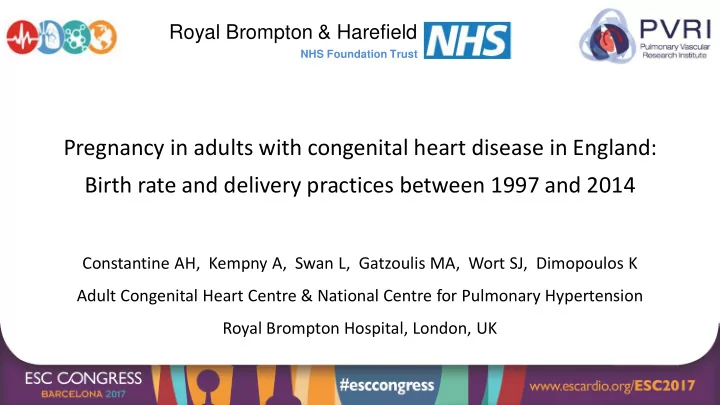

Royal Brompton & Harefield NHS Foundation Trust Pregnancy in adults with congenital heart disease in England: Birth rate and delivery practices between 1997 and 2014 Constantine AH, Kempny A, Swan L, Gatzoulis MA, Wort SJ, Dimopoulos K Adult Congenital Heart Centre & National Centre for Pulmonary Hypertension Royal Brompton Hospital, London, UK
Background • There has been a dramatic expansion in the congenital heart disease (CHD) population of child-bearing age. Pregnancy represents a period of increased risk for women with CHD. • • Planned Caesarean section may not confer any advantage over planned vaginal delivery. Population data of current practice are necessary to inform guidelines and patient consultations. • Methods • Retrospective analysis of the hospital episode statistics database for England from 1997 to 2014. • Pregnant CHD patients were identified using CHD (ICD-10 “Q2”) and pregnancy (OPCS-4 “R0-9”, “O13-15”, “Q1”; ICD-10 “O0-9”) codes. • Where possible, CHD was classified as “simple”, “moderate” or “complex”. • Linear regression analysis was performed ( p < 0.05).
Baseline characteristics & results • From 1997 to 2014, 28,692 delivery episodes occurred in 16,728 CHD patients. • The median age was 28 (range 13 – 52 years). • When classified by CHD complexity: • 60.3% had a simple defect • 31.4% had a moderately complex defect • 8.3% had a greatly complex defect By delivery method, in patients with classifiable lesions: • • 50.1% had spontaneous vaginal delivery • 11.5% had instrumental delivery (forceps, vacuum-assisted) • 38.3% had a Caesarian section
Delivery episodes by disease complexity 2007-14 * * p < 0.00001 (linear regression analysis)
Method of delivery by CHD complexity pre- and post-2007
Conclusions & further work • While pregnancy can carry risks in CHD patients, an increasing number of patients have successful pregnancies. Although Caesarean section is indicated for a minority of patients, the practice appears to be • more common than in the general population. Its use has not decreased over time. • Further analysis of the hospital statistics database for England by our group aims to establish • current outcomes in CHD patients undergoing pregnancy and non-cardiac surgery.
Recommend
More recommend